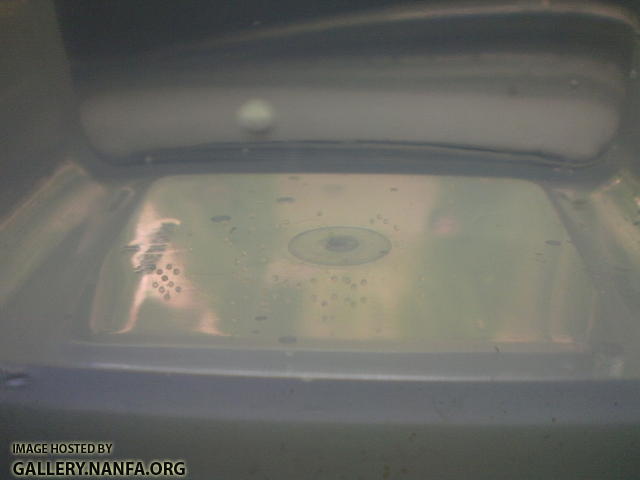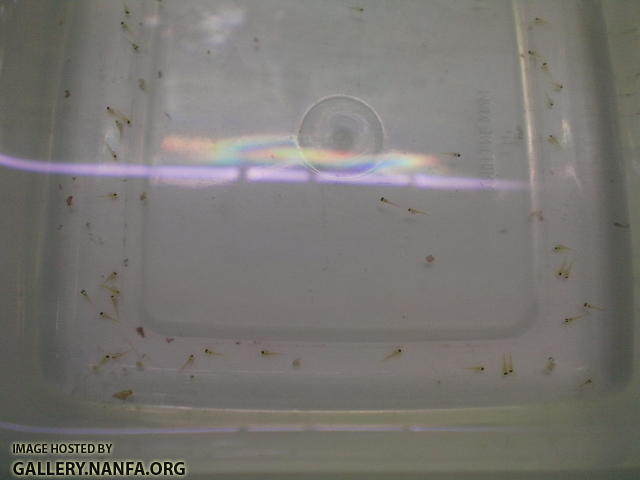I took some video of my tank a few days ago. I think this is mating behavior. I'm not 100% certain since I haven't been able to find much on breeding darters in captivity. But, it's a male and a female by themselves, acting strangely, what else could it be? Anyways, check it out and let me know what you think.
Iowa darters mating?
Started by
Guest_AMcCaleb_*
, Feb 12 2014 01:47 PM
8 replies to this topic
#1
 Guest_AMcCaleb_*
Guest_AMcCaleb_*
Posted 12 February 2014 - 01:47 PM
#2
 Guest_Erica Lyons_*
Guest_Erica Lyons_*
Posted 12 February 2014 - 02:07 PM
Thank you for sharing. It's hard to find videos of this behavior. Are you considering putting them in their own tank for a week then pulling them out to see if you get fry?
#3
 Guest_AMcCaleb_*
Guest_AMcCaleb_*
Posted 12 February 2014 - 03:35 PM
I have a couple tanks that are sitting empty but they aren't cycled and I don't really have any filters for them. I was still trying to make up my mind on what to do with them. I have never tried breeding any type of fish before and if I was going to start I was wanting to start with something a little easier than these. Also, I don't really have the time to devote to fry raising right now as it is. Things are really busy right now. I really just have time for basic tank maintenance and water changes and that's about it. But, if they're breeding now, chances are they'll try it again and somewhere down the road I'll be able to give it a shot.
#4

Posted 12 February 2014 - 03:56 PM
This certainly looks like courting behavior. He is definitely interested and she is not running away much. But there was nothing that looked like a mating event on the video.
Either write something worth reading or do something worth writing. - Benjamin Franklin
#5
 Guest_AMcCaleb_*
Guest_AMcCaleb_*
Posted 12 February 2014 - 04:10 PM
I missed quite a bit before I could find my camera, plus it had already started before I got to the tank. I walked in on the middle of something. But, along those lines, I haven't seen any eggs at all
Day5FishTanks. Any other native YouTubers on here?
Day5FishTanks. Any other native YouTubers on here?
#6
 Guest_Erica Lyons_*
Guest_Erica Lyons_*
Posted 12 February 2014 - 05:20 PM
I wouldn't expect you to. Iowa darter eggs are probably around a millimeter. You can read more here: http://infotrek.er.u...cies_param=1477I haven't seen any eggs at all
"At peak relative ovary mass in June, females were reported to hold both immature white (0.5 mm diameter) and mature orange (1.0 mm diameter) eggs. However, Simon and Faber (1987) suggested that these measurements of immature eggs were actually of the oil globules that had separated from the eggs rather than mature eggs themselves. "
May or may not be true. But regardless, they're small.
#7
 Guest_AMcCaleb_*
Guest_AMcCaleb_*
Posted 12 February 2014 - 05:54 PM
Is there really any material on breeding darters in captivity?
Day5FishTanks. Any other native YouTubers on here?
Day5FishTanks. Any other native YouTubers on here?
#8
 Guest_Erica Lyons_*
Guest_Erica Lyons_*
Posted 12 February 2014 - 06:19 PM
Yes, there's lots of data in the literature.
http://www.researchg...fountain_darter
"ABSTRACT Survival of the fountain darter (Etheostoma fonticola), a U.S. federally listed endangered species, may depend on captive propagation. Studies were conducted to determine the effect of temperature on spawning and to develop methods for culture. The fountain darter spawned and produced viable offspring in aquaria at 27, 24, 21, 18, 15, 12, 9, and 6°C. The fish also spawned at 3 and 30°C but did not produce viable eggs. Daily egg production of individual fish held at 27, 21, 15, and 9°C was variable. The mean critical thermal maximum for the fountain darter was 34.8°C. Early life stages, 4-14 mm long, were offered a variety of live protozoans, rotifers, and microcrustaceans. Food selection varied with fish size and food size. Fountain darters reached sexual maturity in about 180 d when maintained at 21°C. Three-year-old darters produced viable offspring, and several lived longer than 4 years. Tricaine methanesulfonate was an effective anesthetic at 60 mg/L but was fatal to subadults at 100 mg/L."
The problem is that if I had to rank fish as far as ease of breeding goes, I'd divide them in categories.
Livebearers: Easy. Relatively large fry. A little bit tricky to separate from parent (I've killed several batches of fry using commercial breeding separators that stressed the mom out too much), but not really necessary, provided ample food and plant cover. They're fine with eating crushed flake food, no special food necessary.
Cichlid mouthbrooders: Medium. Pros: large fry, can separate from parents and raise in first tumbler then fry tank. Cons: Must learn how to strip eggs.
Egg scatterers: Hard. Small eggs that require certain foods upon hatching and won't be able to eat others. Little to no paternal care, and the adults both can and will eat the babies if you leave the parents in with their eggs too long.
Lobsters: the most difficult thing to breed, ever. My husband was telling me about this the other day and it sounds nearly impossible.
Darters are in the egg scatterer category in my mind in that they leave their eggs somewhere and never think about them again. If they see their young, they eat them. The offspring are very small and require a certain few foods, not accepting crushed flake as their first food. It's not exactly the best fish to start with. The order I'd suggest is to first breed a livebearer (our north american goodeids are an example fish that do well in unheated tanks) and get used to protecting fry from their parents, and separating fry into fry tanks and running those. Then practice live foods, and learn how to culture things. I grow microworms and vinegar eels myself, and now that I've purchased in-tank brine shrimp hatcheries, I have the patience to run those, too. The paper I just referenced discussed feeding the baby darters protozoans, rotifers, and microcrustaceans, things that take culturing. It's not hard, it's just a series of things that take some getting used to. And if you do it wrong, you kill them.
I've figured out that live plants are a must, 'cause ammonia is just not a thing I can keep up with by myself with water changes.


All dead due to ammonia, most likely. Poor little elassoma gilberti babies.
Why plants are useful: http://www.theaquari...ical_Filtration
They eat basically any concentration of ammonia in 4 hours, see table 2.
http://www.researchg...fountain_darter
"ABSTRACT Survival of the fountain darter (Etheostoma fonticola), a U.S. federally listed endangered species, may depend on captive propagation. Studies were conducted to determine the effect of temperature on spawning and to develop methods for culture. The fountain darter spawned and produced viable offspring in aquaria at 27, 24, 21, 18, 15, 12, 9, and 6°C. The fish also spawned at 3 and 30°C but did not produce viable eggs. Daily egg production of individual fish held at 27, 21, 15, and 9°C was variable. The mean critical thermal maximum for the fountain darter was 34.8°C. Early life stages, 4-14 mm long, were offered a variety of live protozoans, rotifers, and microcrustaceans. Food selection varied with fish size and food size. Fountain darters reached sexual maturity in about 180 d when maintained at 21°C. Three-year-old darters produced viable offspring, and several lived longer than 4 years. Tricaine methanesulfonate was an effective anesthetic at 60 mg/L but was fatal to subadults at 100 mg/L."
The problem is that if I had to rank fish as far as ease of breeding goes, I'd divide them in categories.
Livebearers: Easy. Relatively large fry. A little bit tricky to separate from parent (I've killed several batches of fry using commercial breeding separators that stressed the mom out too much), but not really necessary, provided ample food and plant cover. They're fine with eating crushed flake food, no special food necessary.
Cichlid mouthbrooders: Medium. Pros: large fry, can separate from parents and raise in first tumbler then fry tank. Cons: Must learn how to strip eggs.
Egg scatterers: Hard. Small eggs that require certain foods upon hatching and won't be able to eat others. Little to no paternal care, and the adults both can and will eat the babies if you leave the parents in with their eggs too long.
Lobsters: the most difficult thing to breed, ever. My husband was telling me about this the other day and it sounds nearly impossible.
Darters are in the egg scatterer category in my mind in that they leave their eggs somewhere and never think about them again. If they see their young, they eat them. The offspring are very small and require a certain few foods, not accepting crushed flake as their first food. It's not exactly the best fish to start with. The order I'd suggest is to first breed a livebearer (our north american goodeids are an example fish that do well in unheated tanks) and get used to protecting fry from their parents, and separating fry into fry tanks and running those. Then practice live foods, and learn how to culture things. I grow microworms and vinegar eels myself, and now that I've purchased in-tank brine shrimp hatcheries, I have the patience to run those, too. The paper I just referenced discussed feeding the baby darters protozoans, rotifers, and microcrustaceans, things that take culturing. It's not hard, it's just a series of things that take some getting used to. And if you do it wrong, you kill them.
I've figured out that live plants are a must, 'cause ammonia is just not a thing I can keep up with by myself with water changes.

All dead due to ammonia, most likely. Poor little elassoma gilberti babies.
Why plants are useful: http://www.theaquari...ical_Filtration
They eat basically any concentration of ammonia in 4 hours, see table 2.
#9

Posted 12 February 2014 - 08:23 PM
Sure there are several NANFA members that are breeding darters in tanks. BOD member Bob Muller and Iowa Regional Rep Ken Glalkin come to mind immediately. There may be others I am forgetting.
Either write something worth reading or do something worth writing. - Benjamin Franklin
1 user(s) are reading this topic
0 members, 1 guests, 0 anonymous users









